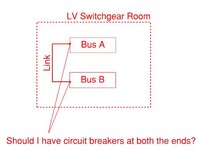NickParker
Electrical
We have a space constraints preventing a long switchboard, so we want to segregate the switchgear by sections Bus A and Bus B as shown in the below figure.
The questions are,
1) The link - to be connected by cables or bus ducts (distance less than 10 meter)
2) Should I have bus tie breaker at the both the ends of Bus-A and Bus-B?

The questions are,
1) The link - to be connected by cables or bus ducts (distance less than 10 meter)
2) Should I have bus tie breaker at the both the ends of Bus-A and Bus-B?

